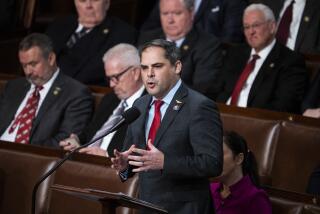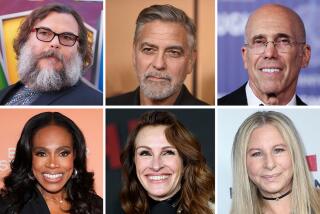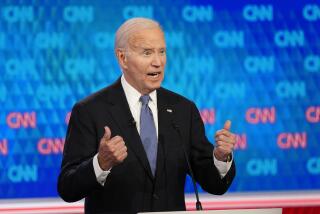Agencies Live, Die With Candidates
- Share via
Last Tuesday was one tough day for Robert Goodman.
His name didn’t appear on any election ballots, but four Republican candidates for the U.S. Senate, who spent a combined $10 million on advertising, placed their ad aspirations in the hands of his Baltimore media consulting firm.
All four lost.
“We’ll be hard-pressed to put much of a presentation reel together for the 1988 election,” said Goodman, president of Robert A. Goodman Agency, which has previously played a hand in ad campaigns for 17 senators. “This time, all we’ve got is tombstones.”
On the other hand, it was a euphoric election for Roger Ailes, whose New York media consulting firm, Ailes Communications Inc., handled campaigns for seven Republican senators, two governors (including George Deukmejian) and four congressmen--of which 10 of 13 were winners.
“You live and die by your results,” said Ailes. “This year we lived pretty well.”
Agency executives say that if their clients weren’t voted in this time around, their agencies may be voted out for the ’88 elections.
Meanwhile, in keeping with a long-held tradition, big-name ad agencies such as Ogilvy & Mather and J. Walter Thompson turned up their noses at political advertising in 1986 and say they will continue to do so.
“I don’t know of one single big ad agency that gets involved in political campaigns,” said Joseph R. Cerrell, president of the American Assn. of Political Consultants and chairman of the Los Angeles media consulting firm Cerrell Associates Inc. “They all think this is Mom and Pop stuff, but believe me, it’s not.”
That leaves a tremendous pot for the little-known ad agencies and media consulting firms that venture into the political arena. In 1988, office seekers are expected to spend a record $2 billion-plus on various forms of advertising and marketing--nearly twice the $1.2 billion spent in 1986, estimates Herbert Alexander, director of the Los Angeles-based Citizens’ Research Foundation. “But when you think about it,” Alexander said, “that’s really peanuts to maintain a democratic system.”
In California alone, U.S. Senate candidates spent an estimated $20 million in advertising--about $15 million of that on TV. And in the race for the governor’s seat, Deukmejian spent an estimated $5 million on advertising to Los Angeles Mayor Tom Bradley’s estimated $2.5 million.
Even with those big ad dollars up for grabs, major ad agency executives say politics is too hot to handle. Political ad campaigns often have to be scrapped or revamped at the last minute and sometimes have to be thrown together in a few days, or even a few hours. In addition, the anticipated wrath of politically sensitive shareholders keeps most of the big, publicly held agencies away from the political front.
And then there’s the image factor.
“I am embarrassed by political advertising,” said Jerry McGee, executive vice president and creative director at Ogilvy & Mather’s Los Angeles office. “It doesn’t make the candidates look bad. It makes our industry look bad.”
McGee says the low voter turnout in last week’s election must in part be credited to the poor quality of the advertising. “The electorate got so turned off by the dirty, nasty advertising,” he said, “that they stayed away from the polls.”
But Goodman--the consultant whose clients all lost--isn’t about to throw in the political towel. In fact, two Democratic contenders have already contacted him about the 1988 campaign. “You don’t learn anything from winning,” Goodman reflects, “you learn from losing.”
Saatchi Hires Senior Consulting Executive
The world’s biggest ad agency has made a move that could, in time, also make it one of the biggest consulting firms as well.
Saatchi & Saatchi Co. of London said Monday that it has hired a key senior executive from one of the world’s largest consulting firms to be chairman and chief executive of Saatchi’s consulting operations. Victor Millar 50, who is retiring as one of two managing partners of Arthur Andersen & Co., will join Saatchi on Dec 1.
Saatchi’s latest move is a clear signal that the company recognizes that the consulting industry “is growing at a faster rate than the ad industry,” said a spokeswoman for Saatchi in New York. This year, she said, the company expects that 20% of its anticipated revenue of $183 million will be from consulting.
Cities Launch Efforts to Build New Images
It took years for Palm Springs and West Hollywood to attain their images. Now city leaders are moving to broaden them.
Palm Springs and West Hollywood independently plan to kick off new advertising and marketing campaigns Wednesday to tinker with their images and drum up new business.
For Palm Springs, it will spell the end of the city’s 19-year-old “P.S. I Love You” campaign. Instead, Palm Springs and surrounding environs plan to spend $1 million over the next year to downplay the city’s image as a celebrity retirement mecca and promote the area as a with-it convention and tourism capital.
The new slogan, “Palm Springs, More to Love,” will be unveiled at a meeting of the Travel & Tourism Research Foundation at the Bistro in Beverly Hills. The city’s latest slogan was devised by Los Angeles-based Gumpertz/Bentley/Fried, which also created the original slogan. “We’re trying to sell more than sunshine,” said Dick Fried, president of the firm. “You’ll see more than bathing beauties in our ads.”
Meanwhile, West Hollywood has big plans to create a new image of its own.
At a press conference scheduled Wednesday at the Sunset Marquis hotel, city officials and business persons will announce the kickoff of a $500,000 campaign to attract more business to the city.
Few visitors seem to know much about the city, except possibly that it has a large gay population. Each June, West Hollywood hosts the Gay Pride Parade, which rivals major gay festivals held in San Francisco and New York.
But “generally, people don’t even know when they’re in West Hollywood,” said Debbie Potter, the city’s economic development manager. But, she said, the new campaign will clearly point out that fine eating establishments such as Spago and Chasen’s--often linked with Beverly Hills--are actually in West Hollywood.
The city’s new slogan: “West Hollywood--Where Creativity Gets Down to Business.”
But both Palm Springs and West Hollywood will have to compete with yet another city that plans to launch a new image campaign this week--Des Moines, Iowa.
Deodorizer Tries to Get Foot in Consumer Door
It is--we kid you not--the official shoe deodorizer of the National Basketball Assn.
Stinky Pinky.
And last week, its manufacturer, Houston chemical giant Tenneco Inc., unleashed its soon-to-be-biggest consumer product to the marketplace, with an ad budget of more than $5 million.
Locally, the foot-freshener-in-a-sack has garnered the commercial endorsements of the Los Angeles Lakers, Lazers and Kings. Indeed, Gary Vitti, the Lakers’ trainer, has taken to the TV airwaves to stomp his foot of approval on the oddly named product.
Where did the nutty name come from? Lots of market research, according to Brian Hunkins, a company spokesman. “After all,” he posed, “how can anyone ever forget a name like Stinky Pinky?”
At least one marketing expert says he’d like to forget it. Philip Lindsley, president of Houston-based Salinon Corp., which specializes in naming products, said the name should reflect the product’s benefits. “It’s memorable all right,” he said, “but that’s all it is.”
More to Read
Get the L.A. Times Politics newsletter
Deeply reported insights into legislation, politics and policy from Sacramento, Washington and beyond. In your inbox twice per week.
You may occasionally receive promotional content from the Los Angeles Times.










